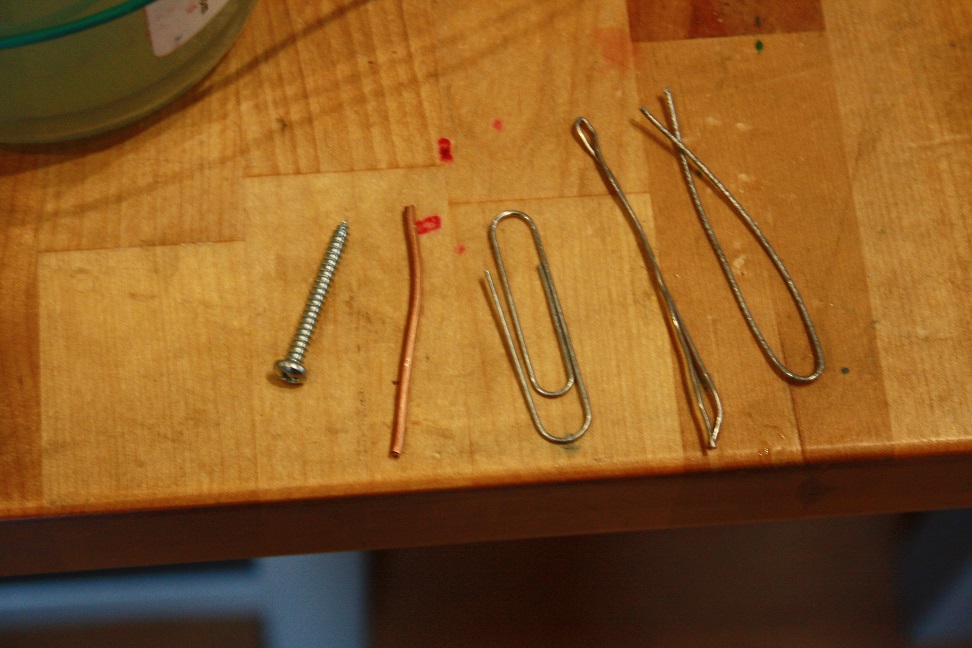- Is Matter Around Us Pure?
We all use different forms of batteries in our everyday life. A battery is defined as a device that can convert the chemical energy of its cell parts into electrical energy. There are different types of batteries which come in different forms and sizes along with the power and energy they can produce. But what if we ever run out of batteries? This science experiment will teach how to produce electricity with ‘Salt’- one of the common household componenst and water.
This experiment mainly aims at exploring components of the battery and focuses primarily on the areas of conductivity in a battery and its effects on the generation of electricity . You may have already seen the usage of batteries in various areas. Here you can explore it in detail.

Materials Required
- Copper-Coated wire
- Zinc Coated Nail
- Graph, Paper
- Two insulated wires with alligator clips on both the ends
- Small Glass Jar
- Measuring Spoons
Step 1: First, prepare a saltwater solution. Take a small amount of water in a jar and mix it well along with two or three pinches of salt.
Step 2: Now place a zinc-coated nail in the solution.
Step 3: Tape the nail to one end of the jar. It should be to the -ve electrode.
Step 4: Attach an alligator clip of one wire to one edge of the coated zinc wire that is falling free outside the solution.
Step 5: The alligator clip can be removed by squeezing.
Step 6: Now, attach the alligator clip of one end of the wire to the -ve terminal of the voltmeter.
Step 7: Connect the copper-coated nail to the +ve terminal of the voltmeter. To do this, repeat the same procedure that has been specified above for zinc-coated nails.
Step 8: Observe the dial of a voltmeter and pen down the readings that determine the amount of current flow between the two electrodes.
Step 9: Once again add a pinch of salt and check the readings. Repeat the same procedure to pen down more readings.
Check out the difference in the readings. It can be plotted in a graph for reference. In a graph, there exists a point where the current stops increasing.
Recommended Videos
Acids and bases.

Interesting experiment, isn’t it? Learn more about such experiments with video lectures and explore the wonders of science with BYJU’S – The Learning App

Put your understanding of this concept to test by answering a few MCQs. Click ‘Start Quiz’ to begin!
Select the correct answer and click on the “Finish” button Check your score and answers at the end of the quiz
Visit BYJU’S for all Chemistry related queries and study materials
Your result is as below
Request OTP on Voice Call
| CHEMISTRY Related Links | |
Leave a Comment Cancel reply
Your Mobile number and Email id will not be published. Required fields are marked *
Post My Comment

Register with BYJU'S & Download Free PDFs
Register with byju's & watch live videos.
Saltwater Pentacell
Make your own battery! Create five simple cells from aluminum foil, copper wire, and saltwater, and connect them in series. Together, they produce enough voltage to light an LED.
- Insulated stranded copper wire, 18 or 20 gauge, that can be cut into five 4-inch (10 cm) pieces. Ordinary lamp cord works well—the two conductors of a 12-inch (30 cm) piece can be pulled apart, and you can then cut three 4-inch (10 cm) pieces from one of them and two from the other.
- Ruler or measuring tape
- Wire strippers
- About 8 inches (20 cm) of aluminum foil from a normal 12-inch-wide (30 cm) roll
- Pitcher or bowl with a spout
- About 1 quart (1 L) of water (not pictured)
- About 2 tablespoons (30 mL) of table salt (sodium chloride)
- Stirring spoon
- Five plastic cups
- Six alligator-clip leads about 12 inches long (exact length not critical)
- Red light-emitting diode (LED)
- About 1 tablespoon (15 mL) of vinegar (acetic acid)
- Measuring spoons

- Cut five pieces of aluminum foil, each about 4 x 4 inches (10 x 10 cm) square. Fold each piece in half, and then in half again, parallel to the first fold, so that the foil square ends up four layers thick, with final dimensions approximately 1 x 4 inches (2.5 x 10 cm). These are your aluminum electrodes.
- Add the salt to the water and stir. This is the electrolyte solution—a liquid that can conduct electricity.
- Fill each plastic cup about three-quarters full of the electrolyte solution. Then put one aluminum electrode and one copper electrode in each cup. The broomlike end of the copper electrode should be in the solution.

- Adjust the two electrodes inside each cup as necessary to make sure that they don’t touch each other.
Use alligator-clip leads to connect the aluminum electrode in the first cup to one leg of the LED, and the copper electrode in the fifth cup to the other leg.
Did the LED light up? Sometimes you have to look directly into the end of an LED to tell if it’s on. If you’re in doubt, darken the room or cup your hands around the LED to block the ambient light.
If the LED isn’t lit, reverse the legs. (A diode—in this case a light-emitting diode, or LED—allows current to flow only in one direction. If it’s connected “backwards,” it won’t light.)
If the LED still doesn’t light, try adding 1/2 teaspoon (2.5 mL) of vinegar to each cup and stirring. The acidity of water varies from place to place, and if your water is not acidic enough, the vinegar may make a difference. If your water is already acidic enough, you probably won’t need to use the vinegar.
After the LED is lit with five cells, try using four cells. If it lights, then try using three cells. What is the smallest number of cells that will do the job?
Each cup, with its electrodes and electrolyte solution, is a simple electrochemical cell. The two electrodes are made of dissimilar materials (in this case, two different metals) with different chemical activities. A tug-of-war for electrons occurs between the two electrodes, resulting in a potential difference, or voltage. In the cells you’ve made, aluminum is the more active metal—atoms of aluminum lose their electrons more easily than do atoms of copper. The potential difference causes electrons lost by the atoms in the aluminum electrode to travel through the LED to the copper electrode, and this flow of electrons is the electric current that lights the LED.
If this flow of electrons continued, and nothing else happened, then fairly quickly there would be a buildup of electrons on the copper electrode and a shortage of electrons on the aluminum electrode.
Because electrons have a negative charge, this would result in the copper electrode becoming negatively charged and the aluminum electrode becoming positively charged. Additional electrons that tried to move from the aluminum to the copper would be repelled by the copper and attracted back to the aluminum, and electron flow would stop.
This is where the saltwater electrolyte solution comes into play. Table salt is sodium chloride, and when it’s dissolved in water, it forms positive sodium ions and negative chloride ions. The positive sodium ions are attracted to the negative copper electrode, where they participate in neutralizing the extra negative charge through chemical reactions. Likewise, the negative chloride ions are attracted to the positive aluminum electrode, where they participate in neutralizing the extra positive charge. Therefore, there’s a constant flow of charge from one electrode through the LED to the other electrode, and then through the electrolyte solution, forming a complete circuit.
The five cells make up a battery when they’re connected in series. (A battery is two or more electric cells that are joined together.) The five-cell battery has five times the voltage of each individual cell.
It takes a minimum voltage to light an LED. If you don’t have enough cells, you won’t provide the necessary voltage.
In any electrochemical cell, the greater the difference in the activity of the two materials making up the electrodes, the greater the strength (voltage) of the cell. Since chemical reactions are taking place at the electrodes, the larger the area of the electrodes, the greater the number of electrons that can be pulled per second, and the larger the current (measured in amperes, or amps).
The big idea here is the difference in the abilities of two materials to lose and gain electrons. This same idea is at the heart of the wide variety of batteries used for everything from flashlights to cell phones. The materials, size, and shape of these batteries may differ from those of this saltwater pentacell, but the general principle remains the same.
A solid choice?
Why does this Snack use stranded wire with the wires spread apart? Try substituting a piece of 18- or 20-gauge solid copper wire. Do you get the same results?
Metals are not created equal
Try using other metals for electrodes. Can you find metals that will allow you to light the LED using fewer cells? Galvanized nails can be used for zinc, regular iron nails for iron, old silverware for silver, and brass hardware for brass. (A commonly available non-metallic material that can also act as an electrode is carbon pencil lead.)
If you have an electrical meter available, try making quantitative measurements of voltage and current for different combinations of metals.
Make a buzz
Try substituting a 1- to 3-volt piezoelectric buzzer for the LED.
We were introduced to this Snack by Art Morrill.
Shakashiri, Bassam. Chemical Demonstrations: A Handbook for Teachers of Chemistry , Vol. 4. Madison: University of Wisconsin Press, 1992. See pages. 91–95 for a general discussion of batteries.
Related Snacks

- Book Lists by Age
- Book Lists by Category
- Reading Resources
- Language & Speech
- Raise a Reader Blog
- Back to School
- Success Guides by Grade
- Homework Help
- Social & Emotional Learning
- Activities for Kids
Kid Maker How-To: Make a Salt Water Battery
Is your child looking for a science project try this idea for a diy battery..
A battery works when electricity is produced by something called an oxidation/reduction (redox) reaction.
In this project, you and your child (adult supervision is required) use two different metals and some salty liquid to create a redox reaction. One metal will oxidize and lose electrons. The other will reduce and gain electrons in the process. These reactions can result produce toxic chemicals, so use these precautions:
- Wash hands before and after experimenting with batteries and electrolytic cells.
- Experiment only in a well-ventilated space.
- Wear latex or nitrile gloves.
- Do not reuse containers you use in this project for food or other non-science purposes.


IMAGES
VIDEO